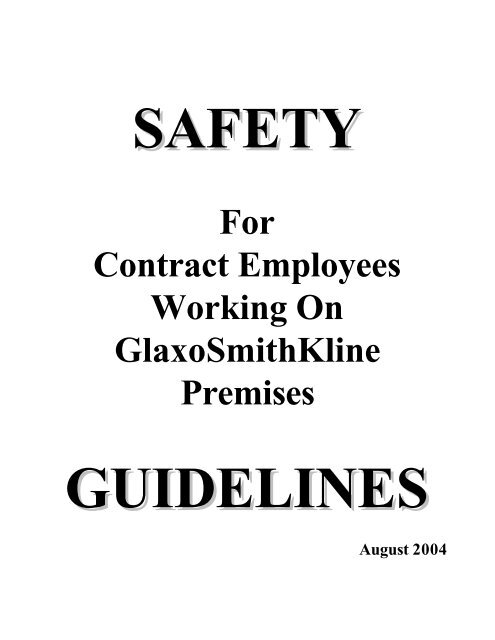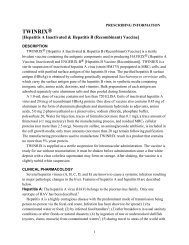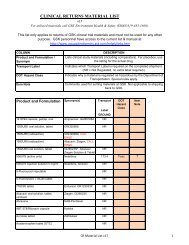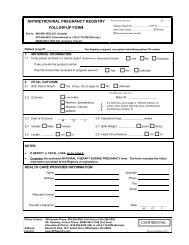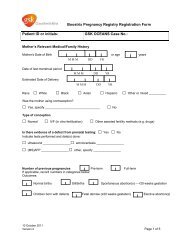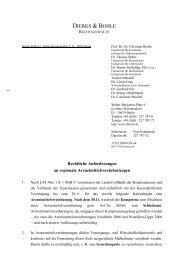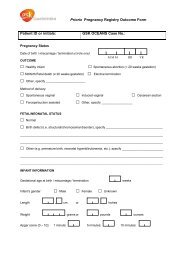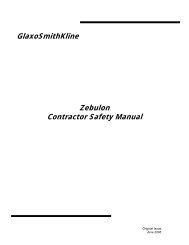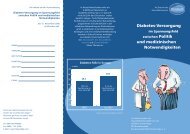Contractor Safety Handbook Eng v2.0 - US Supplier Diversity Home
Contractor Safety Handbook Eng v2.0 - US Supplier Diversity Home
Contractor Safety Handbook Eng v2.0 - US Supplier Diversity Home
- No tags were found...
Create successful ePaper yourself
Turn your PDF publications into a flip-book with our unique Google optimized e-Paper software.
9.6. OPEN BURNING......................................................... 119.7. DISPOSAL OF WASTE IN SANITARY SEWERS............. 119.8. ASBESTOS................................................................. 1210. BIOLOGICAL/CHEMICAL/RADIOACTIVITYHAZARDS.................................................................. 1211. HAZARDO<strong>US</strong> MATERIALS.................................. 1212. COMPRESSED GAS CYLINDERS...................... 1413. ELECTRICAL SAFETY.......................................... 1514. WORKING SAFELY AROUND EQUIPMENT. 1715. PERSONAL PROTECTIVE EQUIPMENT........ 1915.1 CLOTHING................................................................. 1915.2 HARD HATS............................................................. 1915.3 EYE AND HEARING PROTECTION............................... 1915.4 RESPIRATORY PROTECTION ...................................... 2015.5 PROTECTIVE FOOTWEAR........................................... 2015.6 FALL PROTECTION.................................................... 2016. LIFTING.................................................................... 2117. TOOLS....................................................................... 2217.1 HAND TOOLS............................................................ 2217.2 POWER TOOLS .......................................................... 2217.3 POWDER-ACTUATED TOOLS..................................... 24ii
18. WELDING, CUTTING, AND BURNING............ 2419. LADDERS AND SCAFFOLDS.............................. 2520. CRANES AND RIGGING ...................................... 2621. CLOSING STATEMENT........................................ 27iii
1. IntroductionWelcome to GlaxoSmithKline! It is the intent ofGlaxoSmithKline (GSK) to provide a safe and healthfulworking environment. It is your responsibility toensure that your work is performed in a safe mannerthat is in compliance with these <strong>Safety</strong> Guidelines,other GSK safety procedures that may apply (such asLaboratory <strong>Safety</strong>, Radiation <strong>Safety</strong>, and Construction<strong>Safety</strong>), your company’s rules, and local, state andfederal laws and regulations. Work being performed inan unsafe or hazardous manner is unacceptable. Eachperson, regardless of position, must accept his or hersafety responsibilities and be held directly responsibleand accountable for accidents, injuries, and nearmisses.Violations of these guidelines may result intemporary or permanent removal from GSKpremises.While your company is responsible for job safety andcompliance with local, state, and federal regulations,this booklet is being provided to inform you of GSK’srequirements that may be unique to the work area. Yourcompany has agreed to these policies and procedures.You are responsible for knowing evacuation routes,assembly areas, and emergency procedures. If you haveany questions, ask your supervisor.1
This booklet is a general safety orientation and doesnot contain the complete safety program. For moreinformation, ask your supervisor.GSK is proud of its safety record and wants you to be acontributor.2. Emergency Reporting InstructionsIn the event of fire, accident, environmental release, orother emergency, dial the emergency phone number2222. Dial 483-2222 if calling from an externalphone.If there is an evacuation, immediately report to theappropriate assembly area. See your supervisor or oneof the evacuation maps posted in various locations ineach building to confirm the location of theappropriate assembly area.3. Identification Badges and AccessWhile on site, you are required to wear anidentification badge issued by GSK. Badges must beworn at or above the waist and be visible at all times.2
4. General <strong>Safety</strong> and Security RulesThe following are some of the reasons for which anemployee of a contractor may be temporarily orpermanently removed from GSK premises.• Possession or use of alcoholic beverages,regulated drugs not prescribed by a physician,explosives, firearms, ammunition, other weapons,cameras and recording devices• Smoking• Deliberate violation of safety or security rules• Illegal dumping, handling, or disposal of hazardousmaterials• Sexual harassment of any individual or group whileon GSK premises• Destruction or removal without written permissionof any property belonging to GSK, the propertyowner, employee, or other contractors oremployees• Abuse, defacement, or destruction of property, aswell as posting of unauthorized signs, notices, orsolicitations3
• Intimidating, threatening, harassing, impeding orinterfering with an inspector, security officer, orGSK employee• Not obeying posted speed limits and other trafficsigns• Using entrances to the site or a building notdesignated by your supervisor• Using emergency exits other than for emergencies• Falsifying reports, forms, or using anotherperson’s ID badge• Falsely starting or making claims of injury orfailure to report an injury on the day of occurrence• Failing to allow vehicle, parcel, locker, gang box,or lunch box inspection while on GSK property• Loitering, roaming, or leaving assigned work areaswithout authorization• Fighting, creating a disturbance, or horseplay• Careless, uncooperative conduct• Misuse of fire prevention and protectionequipment4
• Unauthorized removal or destruction of a safetybarricade, handrail, guardrail, warning sign, fallprotection, or other warning devices5. <strong>Safety</strong> Permits and ProceduresObtain a permit or approval through your supervisorbefore:• Working on fire protection/detection systems• Doing burning, welding, cutting, soldering,grinding, or other hot work• Working on an electrical circuit• Entering confined spaces (these will be identifiedby your supervisor)• Moving emergency equipment (fire extinguishers,first aid kits, etc.)• Turning off any utility (electrical, compressed air,steam, etc.). Each individual working on a systemmust install their own lockout device on the pieceof equipment as directed by their supervisor. Inaddition, GSK Facilities Operations will shut downand start up operating utilities.• Installing a temporary electrical service5
• Working with hazardous chemicals (includingsolvents and paints)• Using powder actuated tools• Using a gas, diesel, or LP (propane) poweredengine indoors• Operating a power vehicle or self-propelled workplatform• Excavation/trenching• Using radioactive sources or conducting fieldradiography (x-ray)• Working with asbestos-containing materials• Working on security systems• Working with compressed air/gases• Using a laser• Working on a fume or biological hood• Working on a solvent storage cabinet• Working on heating, ventilation, or airconditioning equipment• Working on a roof• Using a tar pot6
• Lifting or hoisting with cranes, derricks, hoists orhelicopter• Performing blasting operationsDo not perform work over the heads of people or leavetools or equipment overhead.Never jump from an elevated platform.Isolate your work area with safety markers, tapebarriers, blinking lights, safety cones, or other means.Report unsafe acts or conditions to your supervisor.6. HousekeepingGood housekeeping is mandatory. Each employee mustkeep his/her work area neat, clean, orderly and free ofexcess trash and debris. If your work area is not keptclean, GSK will have the area cleaned and the costcharged to your company. Neatly stack or store workmaterials and tools in an approved location that doesnot block walkways, stairs, exits, or present a triphazard. Cover and/or guard open holes, trenches, orexcavation.Remember our environment. GSK recycles aluminumand certain types of paper. Ask your supervisor for thelocation of recycling bins before discardingrecyclables.7
7. Alcohol and Drug Abuse8GlaxoSmithKline requires that contract employeesundergo alcohol and drug abuse testing as described inthe GSK <strong>Contractor</strong> <strong>Safety</strong> Manual.8. Accident, Incident, Injury, Illness, and NearMissWork related accidents, incidents, injuries, illnesses,and near misses must be immediately reported to yoursupervisor.9. Environmental Issues9.1. Hazardous Waste Management<strong>Contractor</strong>s are responsible for the safe use anddisposal of any chemicals brought onto a GSK site, andare limited as to the amount of hazardous chemicalthey may store on GSK property. <strong>Contractor</strong>s thatgenerate hazardous waste on site must notifyEnvironmental Health and <strong>Safety</strong> for disposaldirectives.Do not store more than 55 gallons of hazardous wasteor one quart of acutely hazardous waste without writtenapproval from Environmental Health and <strong>Safety</strong>. Wastecontainers must be clearly labeled as to their contents.Waste must not be transferred between GSK facilities.
Do not dispose of hazardous and chemical waste incompany dumpsters.The disposal of waste materials such as asbestos, leadpaint, hazardous construction debris, or contaminatedsoil resulting from demolition, excavation, ormaintenance activities that are not the result ofhazardous materials or petroleum products brought onsite by a contractor must be approved by GSK.9.2. Spill Prevention and ControlUse appropriate protective procedures such as doublecontainment, employee training, overflow protection,and other measures as part of activities involving theuse, storage, or handling of petroleum products orhazardous materials on GSK property.Containers of hazardous materials and petroleumproducts should be stored in order to prevent releasesto the environment. This requires selecting locationsand methods to minimize exposure to rainfall, surfacewater, and the ground. Enclosures, shelters, andsecondary containment should be used whereappropriate.• Prior to discharge of a containment system to thestormwater system, inspect the primary containerfor signs of leakage and inspect the containmentsystem by visual observation for color, foam,outfall staining, visible sheens, and dry weather9
flow. The discharge of a containment system thathas evidence of contamination is prohibited.• The responsible contractor must maintain a logindicating the individual making the observations,description of accumulated stormwater, and thedate and time of release. The log must besubmitted to Environmental Health and <strong>Safety</strong>.9.3. Discharges to Stormwater Conveyance SystemsThe following types of water discharges may bedischarged to the facility’s stormwater conveyancesystems.• Uncontaminated groundwater• Water from foundation drains and footing drains• Air conditioner condensate without addedchemicals• Springs• Uncontaminated potable water• Waterline, sprinkler system, and fire hydrantflushings• Discharges from fire fighting10
An unauthorized or unpermitted non-stormwaterdischarge is considered a release and must be reportedto your supervisor.9.4. Erosion ControlSettling basins and/or straw barricading around stormsewers is required for ground breaking or anycondition that could cause silt to enter a storm sewer.If a construction activity involves five or more acres,obtain a stormwater discharge permit before startingthe work.9.5. Excavation in Environmentally RestrictedAreasExcavation in areas outlined in the general sitedrawings as environmentally restricted is prohibitedunless approved in writing by Environmental Health and<strong>Safety</strong>.9.6. Open BurningOpen burning of debris on company property isprohibited without written approval fromEnvironmental Health and <strong>Safety</strong>.9.7. Disposal of Waste in Sanitary SewersNo hazardous material, chemicals, or petroleumproducts may be disposed of to a sanitary sewer11
12without prior approval from Environmental Health and<strong>Safety</strong>.9.8. AsbestosIf material containing asbestos is suspected orencountered, stop work immediately and notifyEnvironmental Health and <strong>Safety</strong>.10. Biological/Chemical/Radioactivity HazardsSome GSK operations involve the use of biological,chemical, or radioactive material that can be hazardousif not handled safely. Areas where work withbiological, chemical, or radioactive materials is beingperformed will be marked with appropriate signs. Yoursupervisor has the responsibility to advise you ofhazardous materials or areas, the precautions and/orprotective equipment required. Do not handlehazardous biological, chemical, or radioactive materialunless specific approval has been granted by yoursupervisor. Contact your supervisor if you encounter ahazardous situation (biological, chemical, or physicalhazards).11. Hazardous MaterialsDo not handle or use hazardous materials withouttraining. Do not handle or use solvents, compressedgases, or volatile hazardous materials in the proximity
of building air intakes without consulting an authorizedEnvironmental Health and <strong>Safety</strong> representative. Yoursupervisor has an information sheet describing thehazards and precautions associated with materials yourcompany has on the job site.• No solvents, paints, or similar flammable, toxic, orirritating materials may be used in areas occupiedby GSK employees unless specifically approved inwriting by an authorized Environmental Health and<strong>Safety</strong> representative• Maintain adequate ventilation when paints orsolvents are used• Use proper respiratory protection and protectiveclothing• Use flammable solvents and materials withextreme caution• Store flammable paints and solvents in approvedflammable liquid storage cabinets if insidebuildingsYour supervisor will inform you of the proper meansof disposing paints, solvents, or other chemical waste.13
12. Compressed Gas CylindersValve protection caps must be in place whencompressed gas cylinders are transported, moved, orstored.Close cylinder valves and replace valve covers whenwork is complete and when cylinders are empty ormoved.Secure compressed gas cylinders in an upright positionin a welding cart or to a solid object (using chains,straps, or a rigid retaining bar). Secure compressed gascylinders on an approved carrier while beingtransported.Keep cylinders at a safe distance or shielded fromwelding or cutting operations. Do not place cylinderswhere they can contact an electrical circuit.Keep oxygen and flammable gas regulators in properworking order and a wrench in position on theacetylene valve when in use. If not manifoldedtogether, separate oxygen and flammable gas cylindersby 20 feet or a 5 foot high fireproof barrier.If a leak develops in a cylinder and it cannot beimmediately corrected, move the cylinder to a safelocation outside the building.Use only approved spark igniters to light torches.14
Cylinders must not be taken into or stored in confinedspaces, including gang boxes, office/storage trailers, orrooms.Do not store cylinders inside an occupied structure.Do not store hoses and regulators in unventilated orclosed containers or areas.13. Electrical <strong>Safety</strong>Only qualified electricians are permitted to work onelectrical systems and equipment that uses or controlselectrical power.Do not operate electrical tools or equipment in wetareas or areas where potentially flammable dusts,vapors, or liquids are present, unless specificallyapproved for the location.In areas where water or moisture is present or likely tobe present, use ground fault circuit interrupters (GFCI)on power circuits. If permanent plant power circuitsare not GFCI, use a portable GFCI box with electricaltools and equipment. Test interrupters on a regularbasis.Should a circuit breaker or other protective device“trip,” ensure that a qualified electrician checks thecircuit and equipment and corrects problems beforeresetting the breaker.15
Extension cords must be designated for “extra hardusage” and have at least 12 gauge conductors, grounded(3 prong) plugs, be heavily insulated and in a safecondition. Flat electrical cords are prohibited.Inspect extension cords periodically. Damaged cordsmust not be used until repaired. Damaged cords mustonly be repaired with heat shrink material. Electricaltape is not acceptable.Never set up and/or operate equipment such as cranes,lifts, ladders, or scaffolds within 10 feet of overheadpower lines.GSK Facilities Operations will shut down and start upall utility systems and initiate all lockout / tagoutoperations. Always lockout and tag equipment prior toworking on it, in accordance with GSK’s safetyprocedures. Ensure utility service connections to theequipment have been disconnected prior to locking out.Be aware of “stored” energy (capacitive, hydraulic,etc.) which may be present. Test equipment prior toworking on it. Before re-energizing equipment,inspect circuits and the work area to ensure tools,jumpers, grounds, etc. have been removed and thatpersonnel are clear. Also ensure protective guards andcovers are in place before re-energizing. Violation ofthis procedure will result in immediate removal fromGSK premises.16
Avoid wearing rings, necklaces, or other conductiveapparel. Erect barriers and post warning signs toensure non-authorized personnel stay clear of the workarea.Report hazards (lack of protective guards or covers,damaged equipment, etc.) to your supervisorimmediately.Elevate electrical cords at least seven feet above thework area or protect them from damage.Do not leave electrical boxes, switch gear, cabinets, orelectrical rooms open when not directly attended.Insulate energized parts when covers have beenremoved or doors are ajar. Use of cardboard, plywood,or other flammable materials to cover energizedcircuits is prohibited.14. Working Safely Around EquipmentPharmaceutical equipment typically consists of movingmechanical components powered by electricity orcompressed air. Many pieces of equipment are alsoconnected to steam, vacuum, hydraulics, and otherutility services. Therefore, before starting work on apiece of equipment, it is essential that you identifyutility service connections, lockout and tag them, andhave them disconnected in accordance with GSK’s17
policies. GSK Facilities Operations will shut down andstart up affected utilities.Before entering a tank or enclosed vessels, obtain aconfined space entry permit and perform work in theseareas in accordance with GSK’s policies.Take care at all times when working close toequipment, since much of it is automated and may startwithout warning. You must ensure that the equipmenthas safety guards in place and, if required, erect asafety barrier around it. Certain equipment may emit alow level radio frequency or magnetic field and mustbe avoided by individuals wearing pacemakers. Otherequipment may, under adverse conditions, present alow power laser hazard. You will be informed by yoursupervisor of the presence of these hazards and theappropriate precautions.Certain operations involve the use of materials thatmay present a fire or explosion hazard under adverseconditions. These areas may be identified as“classified” or “hazardous” locations. No work ispermitted in these locations without prior approvalobtained by your supervisor.Forklift trucks and other material handling vehicles areused in many areas. You must constantly be alert tovehicle traffic. Gasoline, diesel, or LP gas poweredequipment is not normally allowed in GSK buildings.18
Your supervisor will obtain prior written approvalbefore using this equipment within buildings.15. Personal Protective Equipment15.1 ClothingA shirt with sleeves and long pants must be worn at alltimes. Clothing must not have loose, torn, or draggingfabric. Wear suitable gloves when handling materialsor equipment, and while performing operations thatcould be expected to cause injury to hands or fingers.Wear fully buttoned lab coats, hair nets, and beardcovers in designated areas (available at entries to theseareas). Certain areas require a higher level ofprotection in the form of coveralls or air suits. Do notenter these areas without appropriate clearance,training, and protection.15.2 Hard HatsAn ANSI certified hard hat must be worn at all times indesignated areas.15.3 Eye and Hearing Protection<strong>Safety</strong> glasses with side shields must be worn at alltimes in designated areas in the facility. Additional eyeand/or face protection such as goggles, face shields,and welding shields are required when performing19
operations such as grinding, chemical handling,burning, welding, operating powder actuated tools, etc.Wear approved hearing protection in designated areasin the facility and while working with or around highnoise level equipment, machines and tools (above 85decibels).15.4 Respiratory ProtectionRespirator equipment is required in areas whereinhalation health hazards exist. See your supervisor toobtain appropriate training and protective equipment.15.5 Protective FootwearAthletic-type shoes, sandals, high heels, open-toeshoes, and bare feet are prohibited in non-public areas.Wear appropriate protective footwear in areas wheresafety shoe signs are posted. Appropriate protectivefootwear must be worn when working with corrosivesor hazardous chemicals. All personnel in constructionand demolition areas are required at all times to wearsafety footwear meeting the ANSI Standard Z41-1999requirements for toe-cap protection.15.6 Fall ProtectionA full body safety harness with shock absorbent lanyard(maximum length six feet) and double locking hooks isrequired for employees working at certain heights (in20
accordance with OSHA regulations) when notprotected by guard rails, nets, catch platforms, or otheracceptable methods. <strong>Safety</strong> belts and lanyards are notconsidered acceptable. The following are examples ofareas where fall protection is needed:• Sloping roofs• Flat roofs without standard guard rail• Suspended platform or stage• Scaffold with incomplete guardrail or decking• While installing rebar, setting forms, placingconcrete• Cooling towers• Setting steel, placing decking, etc.This fall protection policy applies to everyone - noexceptions. Secure lanyards to an anchor locationcapable of supporting 5400 pounds, with each tie off asshort as possible. The maximum allowed free-falldistance is six feet.16. LiftingUse proper lifting techniques; use your legs and keepyour back straight. Never try to lift more than you can21
handle safely; consider size, shape and weight. Ask forhelp when moving materials by hand.17. Tools17.1 Hand ToolsEvery tool is designed to do a specific job; use eachtool only for its intended purpose.Keep hand tools in good condition, inspected, clean,sharpened, oiled, and not abused. Replace worn toolsimmediately.Do not force tools beyond their capacity through useof “cheater bars” or by using other shortcuts.Follow manufacturer’s directions and specificationsfor use and care of tools and equipment.17.2 Power ToolsMaintain power tools in good condition and ensureguards are in place before using. Electrical tools mustbe double insulated or properly grounded.Power tools must not be hoisted or lowered by thecord or hose. Use handlines.Do not use power tools unless you have been properlyinstructed in their use. Wear appropriate personal22
protective equipment when using power tools andensure individuals in the immediate area do the same.Elevate cords and hoses at least seven feet above thework area to avoid creating a tripping hazard foremployees or subject the cord/hose to damage.Maintain good footing and use both hands whenoperating power tools. Be ready to release the powerswitch or trigger at the first sign of trouble. Do not usetools with a “lock on” type trigger.Install an approved check valve at the manifold outletof each supply line for hand-held pneumatic tools.Disconnect electrical or compressed air sourcesbefore making adjustments or repairing tools.Closely monitor tool condition and check before eachuse. Tools with damaged or loose parts, ineffectiveguards, or cut/frayed power cords must be taken out ofservice and tagged.Gas and other flammable liquid containers must besafety containers (metal, with spring loaded selfclosinglids) and labeled as to their contents.Do not wear loose clothing, rings or other jewelryaround operating machinery.23
17.3 Powder-Actuated ToolsPowder-actuated tools are not permitted in occupiedGSK buildings without the approval of EnvironmentalHealth and <strong>Safety</strong>. If approval is granted, a hot workpermit issued by a GSK representative must also beobtained by your supervisor.Only employees with a valid license (credential) arepermitted to use powder-actuated tools.Post warning signs when using powder-actuated tools.Wear ear plugs or muffs, and goggles over safetyglasses. Do not leave powder-actuated tools loadedwhen unattended.18. Welding, Cutting, and BurningRemove combustible materials from the area prior tobeginning work.Use appropriate protective clothing and shields for thewelder and helper.Use burning goggles for burning operations. Darkglasses are prohibited.Elevate oxygen/acetylene hoses seven feet above thework area or otherwise protect them from damage.Install anti-flash back (safety/check) valves in both theoxygen/acetylene hoses at the regulator.24
Shield adjacent areas with welding partitions.Have a second person stand by with an approved fireextinguisher for welding and burning operations. Thisperson should remain in the area for a minimum of 30minutes after the hot work is completed to ensure thesite is cold.Obtain a permit from your supervisor for each separateoperation. Permits are issued by GSK.Do not use damaged leads. Connections, including lugson welding machines, must be insulated.19. Ladders and ScaffoldsUse only approved fiberglass ladders in good conditionand of the type suitable for the task. Any metal ladderswould need to be approved by Environmental Healthand <strong>Safety</strong>.Ensure ladders are set level and have secure footing.Step ladders must be fully opened. <strong>Safety</strong> latches onextension ladders must be fully engaged and ladderstied off when working off them.Always face the ladder when climbing or descending.Work facing the ladder with both feet securely on therungs. Never stand on the top step or sit on the top ofthe ladder, straddle the ladder, fold up or lean stepladders, or work two people from the same ladder.25
26Post warning signs when doing overhead work in trafficareas.Obtain permission from your supervisor before settingup a scaffold.Scaffolds must be designed, built, inspected, andtagged by trained, competent persons in accordancewith the latest OSHA requirements. Carefully plan eachapplication to ensure that scaffolds are used whererequired, and that scaffolds conform to the applicablescaffold erection requirements. Ensure the safeworking load is not exceeded.Scaffolds with any dimension of less than 45 inches(such as a Baker-type) must have standard guardrails inplace when the working platform is four feet or higher.Outriggers are also required when the platform is fourfeet or higher.Regular scaffolding must have standard guardrails whenthe working platform is six feet or higher, or else fallprotection must be provided and used.Do not climb on or work from scaffold guardrails orbrace members. Do not ride on a rolling scaffold whenit is being moved, unless it was designed for thispurpose. Remove or secure materials on the workplatform before moving.20. Cranes and Rigging
Each crane, rigging, or hoist brought onto GSKproperty must have an annual inspection performed byan OSHA certified testing agency. Before operationsbegin on site, documentation must be provided to GSKor its designee.The operator is responsible for the proper placementof the crane in relationship to the load to be handledand the landing area so as to obtain the best rated liftcapacity, and the installation and maintenance of craneswing radius protection.21. Closing StatementGSK has a duty to provide a safe workplace that is freefrom recognized hazards. Because of the number ofcontract activities on GSK premises, GSK is providingthis handbook to contract employees as part of itssafety program to protect its people and property. It isthe responsibility of contractors to ensure that theiremployees perform work in a safe manner and in a safework environment. <strong>Contractor</strong>s must train, supervise,and direct their employees concerning compliancewith safety rules, including those required by GSK forwork on its premises. This manual is not intended tonullify or assume responsibility that contractors oweto their employees or to other persons.27
04/2004Contract Employee’s AcknowledgmentTo:GlaxoSmithKline <strong>Safety</strong>I certify that I have received training on theGlaxoSmithKline safety handbook and that I will complywith the requirements for working on GlaxoSmithKlinepremises.Name ________________________________________(Print)Employee ID Number ___________________________Signature _____________________________________Date _________________________________________Company _____________________________________Company Phone ________________________________Facility work performed at: q RTP q ZebulonGSK Contact Person ______________________<strong>Safety</strong> Sticker Number______________________________
Key PersonnelUse this space to record the name and phone number of keypersonnel.To report an accident, fire, etc. ________________________phone numberSupervisor:_________________________________________________name_________________________________________________phone numberSecurity:_________________________________________________name_________________________________________________phone numberOther:_________________________________________________name_________________________________________________phone number_________________________________________________name_________________________________________________phone number


